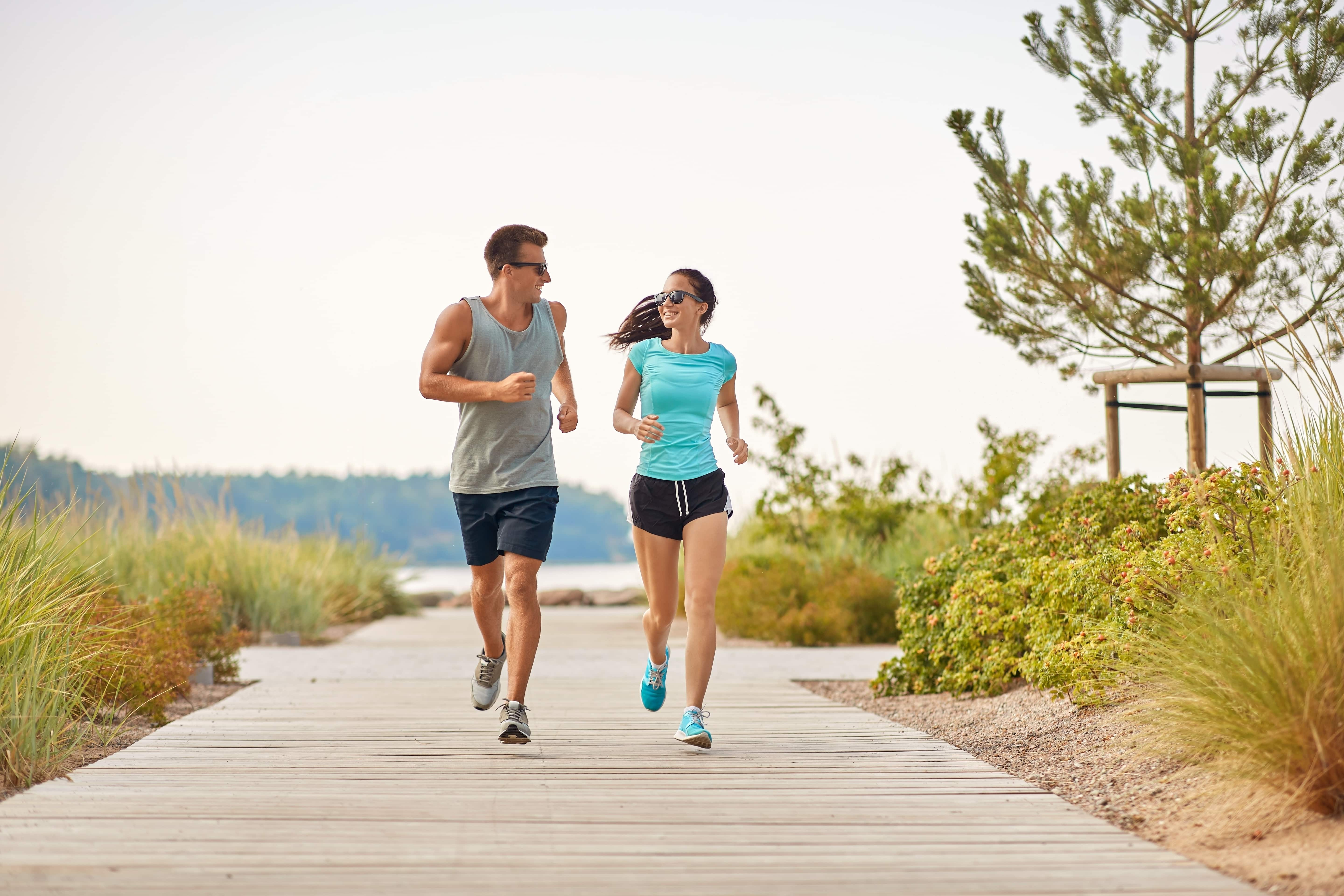Running is an excellent workout. Not only does it boost cardiovascular health and overall fitness, but is great for your mental health too!
However, to get the most out of your runs and protect your body against injuries stretching and warming up is crucial. We all know that we should stretch before workouts. But sometimes it’s easy to skip or rush through this important step so we can hit the road sooner rather than later.
But, skipping this step can lead to muscle tightness, decreased performance, and even injuries. By taking a few minutes to perform the right stretches you can help prepare your body for the work out ahead, enhancing your performance and maximising the benefits.
In this post, we cover some of the benefits of a pre-run stretching routine and some of the best stretches to include. Whether you’re a beginner or an experienced runner, these stretches will help you get ready for a safe and effective run.
The Benefits of Stretching Before a Run
Like any activity, preparation is essential for running. When we're seated or not exercising, many of our muscles contract or shorten. However, during running, these muscles are stretched and if the shift from sitting to running is done too quickly, there is risk of strain and injury. That’s why, stretching before a run helps to reduce this risk by preparing your muscles for the activity ahead.
- Promotes Better Blood Flow: Increased circulation ensures that your muscles are well-oxygenated and ready for the demands of running.
- Reduces the Risk of Injury: By gradually preparing your muscles, you minimise the likelihood of strains and other related injuries.
- Increases Range of Motion: Enhanced flexibility allows for more efficient and safer movements. This is particularly important for trail runners who are navigating uneven terrain and surfaces.
- Improves Performance: Stretches that replicate running motions actively engage muscles, preparing your body for optimal performance during your run.
Dynamic Stretches Vs Static Stretches For Running
We know by now that stretching is beneficial for improving flexibility and range of motion. But did you know that certain types of stretches are better than others? Dynamic and static stretches are both effective stretching techniques that are best suited for different purposes within your workout routine.
Static Stretches
Static stretches involve slowly lengthening a muscle to its limit and holding the position for a period of time. You might be familiar with these types of stretching for school gym classes where you are told to touch your toes or stretch your arms.
Static stretching is most beneficial when done after a workout routine or as a standalone routine. Post-run, these stretches help enhance flexibility, improve range of motion, and promote relaxation, aiding in muscle recovery and reducing soreness.
Dynamic Stretches
But what about warming up and stretching before a run? Dynamic stretches are where it's at. They are an excellent way to prepare your body for a run and involve active movement that gently increases your heart rate, warms up your muscles, and improves your range of motion. You’re your dynamic stretches replicate the activity you are about to perform, such as running, they allow your muscles to stretch and increase blood flow.
Read More: What Are Static Stretches?
The Best Dynamic Stretches Before Your Run
Running is one of the few exercise routines that gets your heat pumping in a way that few others can. But, if you’re not prepared, you’re in for a tough time. Consider some of these pre-run stretches before you hit the pavement next time:
Standing Quad Stretch:
Start with the standing quad stretch to loosen up your quadriceps. Stand on one leg, and pull the opposite foot toward your buttocks, holding it with your hand. Keep your knees close together and hold for a few seconds before switching legs. This stretch activates your quads and prepares them for the running motion.
Leg Swings:
Leg swings are great for warming up your hips and legs. Stand next to a wall or a support for balance. Swing one leg forward and backward in a controlled manner, gradually increasing the range of motion. Repeat with the other leg. You can also do side-to-side leg swings to further engage your hip flexors and adductors.
Arm Swings:
To get your upper body ready, stand with your feet shoulder-width apart and swing your arms forward and backward, keeping them straight. This movement helps loosen your shoulders and increases blood flow to your upper body.
Butt Kicks:
Butt kicks are another excellent way to engage your hamstrings and glutes. While standing, jog in place and kick your heels up towards your buttocks with each step. This dynamic movement helps activate the muscles at the back of your legs, making them more responsive during your run.
Walking Lunges:
Walking lunges effectively warm up your legs and improve your balance. Take a step forward with one leg and lower your body into a lunge position, keeping your knee aligned with your ankle. Push off with your back foot and bring it forward to step into the next lunge. Continue this movement for several steps, alternating legs.
High Knees:
High knees are a great way to get your heart rate up and engage your lower body. Stand tall and run in place, lifting your knees as high as possible with each step. Aim to bring your knees up to waist level, and maintain a brisk pace to activate your core and leg muscles.
Side Lunge:
The side lunge targets your inner thighs and hip adductors. Stand with your feet wide apart and shift your weight to one leg, bending that knee while keeping the other leg straight. Lower your body into a side lunge position, then return to the starting position and switch sides. This stretch helps improve lateral movement and flexibility.
Standing Calf Raise:
Running can put a lot of strain on your calves. This stretch engages both leg muscles, so there is no need to stretch. Stand with your feet hip-width apart and lift your heels off the ground, rising onto your toes. Hold for a moment, then lower your heels back down. Repeat this movement to activate your calf muscles and improve ankle stability.
Should You Stretch For Different Types of Runs?
Of course! Different runs place different demands on your body, and preparing your muscles accordingly can significantly enhance your performance and reduce the risk of injury
Short-Distance Runs
For short-distance runs, such as a quick jog or 5k, focus on dynamic stretches that involve active movement. Leg swings, butt kicks, and walking lunges are excellent choices as they increase blood flow and warm up the muscles. These stretches help prepare your body for a faster pace and quick foot turnover.
Long-Distance Runs
When it comes to long-distance runs like marathons, stretches that target major muscle groups are essential. Calf stretches, hamstring stretches, and quad stretches to alleviate muscle stiffness and improve flexibility. Holding these stretches for about 30 seconds on each leg will help lengthen and relax the muscles, reducing the chances of injury during the run and prepares your muscles for prolonged exertion
Sprints or Interval Training
For sprinting or high-intensity runs, incorporate both dynamic and static stretches. Begin with dynamic stretching to warm up the entire body, then follow it up with deeper stretches to increase flexibility and prepare the muscles for explosive movements.

How to Prepare for Your Pre-Run Stretch
- Choose a Flat Surface: To perform your stretches safely and effectively, find a flat, stable surface. This will provide the necessary support and balance, reducing the risk of slips or falls. A flat surface also ensures that your stretches are performed correctly, targeting the intended muscle groups without added strain.
- Wear Appropriate Footwear: Wearing the right footwear is crucial for both your run and your stretching routine. Choose shoes that provide adequate support and cushioning, especially if you’ll be incorporating dynamic stretches.
- Engage the Entire Body: When preparing for your pre-run stretch, make sure to engage your entire body. Stretching isn’t just about your legs; it’s important to include movements that warm up your upper body, core, and lower body. This comprehensive approach ensures that all muscle groups are ready for the physical demands of running.
- Incorporate Breath Work: Incorporating breathwork into your stretching routine enhances its effectiveness. Deep, controlled breathing helps oxygenate your muscles and can aid in relaxation, making your stretches more effective. Focus on inhaling deeply through your nose and exhaling slowly through your mouth, synchronising your breath with your movements.
- Consider Props: Using props can enhance your stretching routine by providing additional support and helping you achieve deeper stretches. These can include using a yoga mat for cushioning, a strap or band to assist with flexibility, or a foam roller to massage and prepare your muscles. These tools can make your stretching routine more effective and comfortable, especially if you have specific areas that need extra attention.
- Don’t Forget To Listen To Your Body! Remember, regardless of the type of run, it's important to always listen to your body. If you experience any pain or discomfort during stretching, modify or stop the stretch immediately.
Need Help Stretching?
If you find stretching challenging or want to enhance your stretching routine, Stretch Lab is here to help you! Our team of highly trained Flexologists® can provide you with a deeper, more effective stretch. Plus, with studios located across Australia, including Claremont, Currambine, Balgowlah, Highgate, South Perth, Five Dock and many more. finding us is quick and easy!
Our one-on-one sessions are customized to fit your individual needs. Whether you're focusing on specific problem areas or targeting certain muscle groups, our Flexologists® will design a stretching program tailored to your body.
But, If you enjoy the energy of a group setting, we offer guided group stretches as well. In these sessions, our Flexologists® will lead you through a series of stretches and teach you the proper use of stretching tools.
![]()
Run With Confidence!
Incorporating proper stretching into your running routine can make a world of difference. By understanding the benefits of pre-run stretching and preparing your body correctly, you can enhance your performance and reduce the risk of injury.
Whether you’re a beginner or an experienced runner, taking a few minutes to stretch before and after your runs is an investment in your long-term fitness and well-being.
If you need help with your stretching routine or want to experience the benefits of deeper, more effective stretches, Stretch Lab is here for you. Visit Stretch Lab today and discover how expert guidance can transform your running routine. Book your session now and run with confidence!


%20(1).jpg?width=6000&height=4000&name=Stretch_Lab-27_(1)%20(1).jpg)


.jpg?width=600&name=StretchLab_%20(120).jpg)
